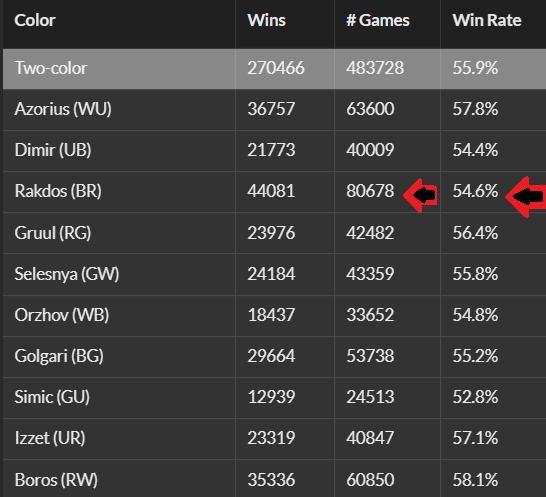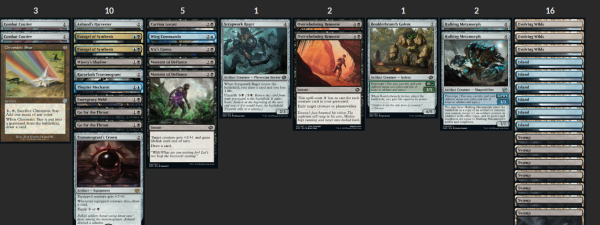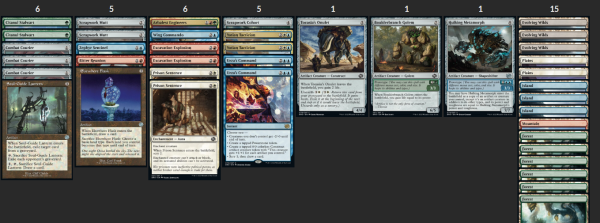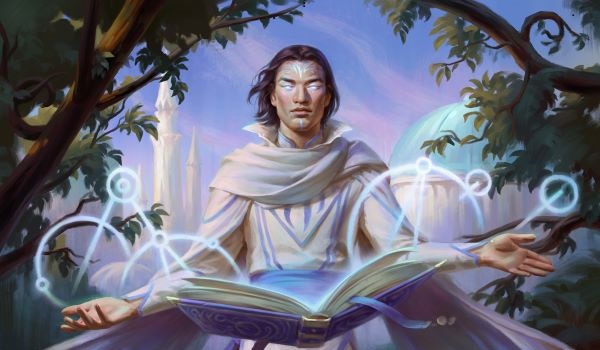Are you a Quiet Speculation member?
If not, now is a perfect time to join up! Our powerful tools, breaking-news analysis, and exclusive Discord channel will make sure you stay up to date and ahead of the curve.
Each Limited format in the modern era is guided by a series of signpost uncommons. Theoretically these cards outline a plan for each color combination and point to synergies we should aspire to assemble. In our preview article for The Brothers' War (BRO), we recognized that these archetypes were poorly supported at common.
You Call This Support?
These cards are playable in the right deck, and sometimes they might even do the thing they're supposed to do. However, they mostly represent their stats, with slight upside. Even in a supported archetype, they rarely outperform their status as filler.
Compare this to Dominaria United (DMU), where the commons elevated their respective archetype with far greater impact.
The Art of the Archetype
DMU's archetypes are well-supported at common. The cards are powerful and coveted. BRO's archetypes are mostly unsupported at common. These are cards we hope to leave out of our decks. This dichotomy creates two very different formats and dictates the way we should be drafting and building our decks.
The Exception to the Rule
BR Sacrifice is the biggest exception. It has plenty of cards that contribute to its theme. As a result, this color combination is the most drafted in the format by a wide margin. Furthermore, this phenomenon occurs despite a pretty mediocre win percentage.

When it comes to BR Sacrifice, we can choose between Goblin Blast-Runner aggro, or something more attrition based, the grindiest of which utilizes Clay Revenant. All of these decks want Penregon Strongbull and will probably make good use of Powerstone Fracture.
Nevertheless, they all prioritize various cards differently. How important is Bitter Reunion compared to Sibling Rivalry? When will they select Roc Hunter over Emergency Weld? Is Thraxodemon good here? Deviation in these answers reveals the wide range of decks that fall under the label of BR Sacrifice.
BR Sacrifice is so supported at common, it actually represents multiple archetypes. This, however, is the exception.
Living Outside of the Archetypes
We were told the format would be driven by UR Spells, GW Artifact-Fall, and BG Graveyard decks. This was never the reality of the format. While UW Soldiers, for example, can come together, there is very little incentive to prioritize the namesake tribal cards. We can count the "soldier" payoffs that exist outside of rare or mythic on one hand.
- Air Marshal
- Aeronaut Cavalry
- Yotian Tactician
- Zephyr Sentinel
That's it for the entire format. Similarly, Spells gets a couple prowess dorks. Graveyard gets some unplayable mill cards and Emergency Weld. Ironically, green, one of the "graveyard matters" colors, is the only color in the format to not have access to unearth at common.
As a result, the format spiraled away from these archetypes over the first weeks. The signpost uncommons are good; we just don't want to focus on building around them. Instead, our focus should be to build functional decks around macroarchetypes. In this format, the most relevant macroarchetypes are aggro, midrange, and splashy ramp decks typically built around Citanul Stalwart.
Aggro Preys on Clunky Strategies
Just because the format didn't utilize the scripted archetypes for each color combination does not mean it was without synergy. Collecting all of the artifacts for a GW deck is not nearly as important as building a plan and getting the powerful cards to execute it.
The first narrative to emerge from the format was that this was an aggressive format. Red and white decks, the most aggressive in BRO, were able to beat down while their opponents fumbled around with retro artifacts, desperate to enable draw-two synergies. Fallaji Vanguard triggers stacked, and unearth creatures sprinted from the graveyard as the fragile combinations of focused archetypes failed to matter.
The aggressive decks took round one, and considering their outstanding win rate, have held on to be the dominant presence in the format. Currently red and white are the two winning colors in mono-colored decks, and their combination is the best in the format, with or without a splash. While these decks don't look for a particular build-around, maximizing the aggressive cards is a winning strategy in most formats. Because draft has a self-correcting nature, red dried up especially quickly.
What Is a Glue Card?
A glue card is a card that can enable multiple different plans, but especially slower midrange strategies. The more ambitious our game plan, the more essential the glue cards will be. Because the default strategies in this format are aggressive ones, midrange and slower decks are, in turn, more ambitious and more difficult to build. It does not mean, however, that they are less powerful.
These should be cards that are easily cast and provide value. They enable options. The Mutt's ability to rummage helps us get to the cards we need. Boulderbranch Golem buys us time through gaining life. Energy Refractor is another example, as it helps solidify otherwise dubious mana bases.
The best versions of these cards prevent us from falling behind on the battlefield, which is essential against aggressive decks. We can't rely on glue cards if they're going to put us too far behind on any one particular access. Energy Refractor replaces itself in a card in your hand, but because it can cause us to fall behind on the battlefield, it's less valuable than some other options.
The unearth cards often represent great glue cards. Being colorless makes them easy to cast. They are aggressive by nature of the mechanic. However, in slower decks, they give us value with multiple cracks at their ETB or activated abilities. Many of these cards help us survive and can work in any number of decks. They are valuable when playing a long game.
The Power of Glue
While some of the smaller archetypes failed to come together, the use of the format's many glue cards generated enough value to allow some opposition to thrive as the aggressive colors became overdrafted.
Hold It Together
These cards emerged as essential pieces to fighting aggressive decks. While they still might see play in such decks, having access to them allows us to buy time without sacrificing power. These cards trade with aggressive decks and leave some value in their wake. As we use these glue cards, more options materialize in deck construction. They fit into almost any deck, and with minor access to their splash, we can access their full value. These cards should be early picks because of their strength and flexibility.
UB Draw 2 might not be a real option, but these glue cards allow midrange to thrive, as long as they're supporting powerful cards. We can access some minor support from the archetype while relying on more consistent commons.

7-1 UB Good Stuff
This is hardly a Draw 2 deck, though clearly it incorporates strong uncommons from the archetype. Rather, this is simply a streamlined collection of cards that utilizes glue pieces to make the most of the open colors in the draft.
Last week, we discussed the power of Multi-Colored Stalwart, a deck that uses Citanul Stalwart to splash powerful cards. However, this deck can't get to its robust late game if it can't resist aggo. The glue cards are essential pieces to allowing this strategy to flourish.

7-2 Double Command Stalwart
This deck uses some of the format's glue cards to get to the late game. At that point, the powerful uncommons and double Urza's Command can overpower opponents. Hulking Metamorph acting as a third Yotian Tactician was pretty nice too.
Glue Cards vs. Archetypes
The glue cards in this format are archetype agnostic. They also represent the best commons in the format. Back in DMU, the best commons were mostly at home in specific archetypes. As a result, the formats play out differently.
When we are more incentivized to play glue cards than archetype-defining commons, we are more likely to want to build towards macroarchetypes than towards traditional signpost uncommons. Aggressive decks, followed by splashy ramp decks, followed by slower midrange decks represent the pecking order in BRO, though some tastes may vary. The pecking order in DMU was tied to the specific archetypes, such as Spell-Based Aggro, Big Domain, or Go Wide White Decks (my official ranking is listed here).
Shine a Little Light
Recently, I've been drafting a ton of blue, and I'm doing it for the uncommons. This week, I want to talk about a first amongst equals, Zephyr Sentinel.
This card and Thopter Mechanic are two great reasons to be blue. The color is the weakest in the format, but is drafted like it's unplayable. Getting one of these premium uncommons early lets us speculate on a color that might well be wide open. Zephyr Sentinel can be a great source of pressure or an incredible trick. Saving a valuable creature in a crucial moment or flashing in two or three points of evasive power during our opponent's end step can swing a game.
I hadn't explored blue much until the last two weeks. My white decks sometimes leaned into it, but I never really pursued it. As the format is winding down, take a shot at its most under-drafted color. But don't be afraid to get off it if you're not seeing the good stuff.




